Virtex-5 Libraries Guide for
Schematic Designs
ISE 8.2.2
R
�
R
R
Xilinx is disclosing this Document and Intellectual Property (hereinafter “the Design”) to you for use in the development of designs to operate
on, or interface with Xilinx FPGAs. Except as stated herein, none of the Design be copied, reproduced, distributed, republished,
downloaded, displayed, posted, or transmitted in any form or by any means including, but not limited to, electronic, mechanical,
photocopying, recording, or otherwise, without the prior written consent of Xilinx. Any unauthorized use of the Design violate copyright laws,
trademark laws, the laws of privacy and publicity, and communications regulations and statutes.
Xilinx does not assume any liability arising out of the application or use of the Design; nor does Xilinx convey any license under its patents,
copyrights, or any rights of others. You are responsible for obtaining any rights you require for your use or implementation of the Design.
Xilinx reserves the right to make changes, at any time, to the Design as deemed desirable in the sole discretion of Xilinx. Xilinx assumes no
obligation to correct any errors contained herein or to advise you of any correction if such be made. Xilinx will not assume any liability for the
accuracy or correctness of any engineering or technical support or assistance provided to you in connection with the Design.
THE DESIGN IS PROVIDED “AS IS” WITH ALL FAULTS, AND THE ENTIRE RISK AS TO ITS FUNCTION AND IMPLEMENTATION IS
WITH YOU. YOU ACKNOWLEDGE AND AGREE THAT YOU HAVE NOT RELIED ON ANY ORAL OR WRITTEN INFORMATION OR
ADVICE, WHETHER GIVEN BY XILINX, OR ITS AGENTS OR EMPLOYEES. XILINX MAKES NO OTHER WARRANTIES, WHETHER
EXPRESS, IMPLIED, OR STATUTORY, REGARDING THE DESIGN, INCLUDING ANY WARRANTIES OF MERCHANTABILITY, FITNESS
FOR A PARTICULAR PURPOSE, TITLE, AND NONINFRINGEMENT OF THIRD-PARTY RIGHTS.
IN NO EVENT WILL XILINX BE LIABLE FOR ANY CONSEQUENTIAL, INDIRECT, EXEMPLARY, SPECIAL, OR INCIDENTAL DAMAGES,
INCLUDING ANY LOST DATA AND LOST PROFITS, ARISING FROM OR RELATING TO YOUR USE OF THE DESIGN, EVEN IF YOU
HAVE BEEN ADVISED OF THE POSSIBILITY OF SUCH DAMAGES. THE TOTAL CUMULATIVE LIABILITY OF XILINX IN CONNECTION
WITH YOUR USE OF THE DESIGN, WHETHER IN CONTRACT OR TORT OR OTHERWISE, WILL IN NO EVENT EXCEED THE
AMOUNT OF FEES PAID BY YOU TO XILINX HEREUNDER FOR USE OF THE DESIGN. YOU ACKNOWLEDGE THAT THE FEES, IF
ANY, REFLECT THE ALLOCATION OF RISK SET FORTH IN THIS AGREEMENT AND THAT XILINX WOULD NOT MAKE AVAILABLE
THE DESIGN TO YOU WITHOUT THESE LIMITATIONS OF LIABILITY.
The Design is not designed or intended for use in the development of on-line control equipment in hazardous environments requiring fail-
safe controls, such as in the operation of nuclear facilities, aircraft navigation or communications systems, air traffic control, life support, or
weapons systems (“High-Risk Applications”). Xilinx specifically disclaims any express or implied warranties of fitness for such High-Risk
Applications. You represent that use of the Design in such High-Risk Applications is fully at your risk.
Copyright © 1995-2006 Xilinx, Inc. All rights reserved. XILINX, the Xilinx logo, and other designated brands included herein are trademarks
of Xilinx, Inc. PowerPC is a trademark of IBM, Inc. All other trademarks are the property of their respective owners.
2
www.xilinx.com
Virtex-5 Libraries Guide for Schematic Designs
ISE 8.2.2
�
R
About this Guide
The Virtex™-5 Libraries Guide for Schematic Designs is part of the ISE documentation
collection. A separate version of this guide is also available for users who prefer to
work in a hardware description language (HDL) in their circuit design activities. (See
Virtex™-5 Libraries Guide for HDL Designs.)
Guide Contents
Information about additional resources and conventions used in this guide.
This guide contains the following:
•
• A general introduction to the Virtex-5 primitives and macros.
• A listing of the Functional Categories into which Virtex-5 design elements are
organized.
Individual sections for each of the applicable design elements.
•
Additional Resources
To find additional documentation, see the Xilinx website at:
http://www.xilinx.com/literature.
To search the Answer Database of silicon, software, and IP questions and answers, or
to create a technical support WebCase, see the Xilinx website at:
http://www.xilinx.com/support.
Conventions
This document uses the following conventions. An example illustrates each
convention.
Typographical
The following typographical conventions are used in this document:
Convention
Meaning or Use
Example
Courier font
Courier bold
Messages, prompts, and program
files that the system displays
Literal commands that you enter in
a syntactical statement
speed grade: - 100
ngdbuild design_name
Virtex-5 Libraries Guide for Schematic Designs
ISE 8.2.2
www.xilinx.com
3
�
R
Convention
Meaning or Use
Example
Helvetica bold
Italic font
Square brackets [ ]
Braces { }
Vertical bar |
Vertical ellipsis
.
.
.
Commands that you select from a
menu
Keyboard shortcuts
Variables in a syntax statement for
which you must supply values
References to other manuals
Emphasis in text
File → Open
Ctrl+C
ngdbuild design_name
See the Development System
Reference Guide for more
information.
If a wire is drawn so that it
overlaps the pin of a symbol,
the two nets are not connected.
ngdbuild [option_name]
design_name
An optional entry or parameter.
However, in bus specifications,
such as bus[7:0], they are
required.
A list of items from which you
must choose one or more
Separates items in a list of choices lowpwr ={on|off}
Repetitive material that has been
omitted
lowpwr ={on|off}
IOB #1: Name = QOUT’
IOB #2: Name = CLKIN’
.
.
.
allow block block_name loc1
loc2 ... locn;
Horizontal ellipsis . . .
Repetitive material that has been
omitted
Online Document
The following conventions are used in this document:
Convention
Meaning or Use
Example
Blue text
Red text
Cross-reference link to a location
in the current document
Cross-reference link to a location
in another document
Blue, underlined text Hyperlink to a website (URL)
See the section “Additional
Resources” for details.
See Figure 2-5 in the Virtex-4
Handbook.
Go to http://www.xilinx.com
for the latest speed files.
4
www.xilinx.com
Virtex-5 Libraries Guide for Schematic Designs
ISE 8.2.2
�
Introduction
R
Xilinx maintains software libraries containing hundreds of functional design elements
(primitives and macros) for various device architectures. New functional elements are
assembled with each release of development system software. The catalog of design
elements is known as the Xilinx Unified Libraries. Elements in these libraries are
common to multiple Xilinx device architectures. This “unified” approach means that
you can use your circuit design created with “unified” library elements across many
Xilinx device architectures that recognize the element you are using.
Elements that exist in multiple architectures look and function the same, but their
implementations might differ to make them more efficient for a particular
architecture. A separate library still exists for each architecture and several hundred
design elements (primitives and macros) are available across multiple device
architectures, providing a common base for programmable logic designs.
Starting in 2004, libraries guides began to be published only for the latest available
architectures. This architecture-specific approach is also published in a two-volume
set: one for designers who prefer to use hardware description language (HDL), and
one for those who prefer to use schematics.
The Virtex-5 Libraries Guide describes the primitive and macro logic elements
supported under the Virtex-5 architecture. Common logic functions can be
implemented with these elements and more complex functions can be built by
combining macros and primitives.
Functional Categories
The functional categories list the available design elements in each category, along
with a brief description of each element supported under each Xilinx architecture.
Attributes and Constraints
The terms attribute and constraint have been used interchangeably by some in the
engineering community, while others ascribe different meanings to these terms. In
addition, language constructs use the terms attribute and directive in similar yet
different senses. For the purpose of clarification, the following distinction can be
drawn between these terms.
An attribute is a property associated with a device architecture primitive that affects
an instantiated primitive’s functionality or implementation. Attributes are typically
conveyed as follows:
•
•
In VHDL, by means of generic maps.
In Verilog, by means of defparams or inline parameter passing during the
instantiation process.
Constraints impose user-defined parameters on the operation of ISE tools. There are
two types of constraints:
•
Synthesis Constraints direct the synthesis tool optimization technique for a
particular design or piece of HDL code. They are either embedded within the
VHDL or Verilog code, or within a separate synthesis constraints file.
Implementation Constraints are instructions given to the FPGA implementation
tools to direct the mapping, placement, timing, or other guidelines for the
•
Virtex-5 Libraries Guide for Schematic Designs
ISE 8.2.2
www.xilinx.com
5
�
R
implementation tools to follow while processing an FPGA design.
Implementation constraints are generally placed in the UCF file, but can exist in
the HDL code, or in a synthesis constraints file.
Attributes are identified with the components to which they apply in the libraries
guide for those components. Constraints are documented in the Xilinx Constraints
Guide. Both resources are available from the Xilinx Software Manuals collection.
The Retargeting of Virtex-5 Design Elements
To ensure that Xilinx customers are able to take full advantage of the latest circuit
design advances, certain pre-existing design elements are automatically changed by
the ISE software tools when they are used under the Virtex-5 architecture.
The following table lists the pre-existing elements and the more advanced elements
into which they are transformed:
Pre-Existing
Modern Equivalent
BUFGCE_1
BUFGMUX
BUFGMUX_1
BUFGMUX_VIRTEX4
BUFGP
DCM_BASE
DCM_PS
DSP48
FD
FD_1
FDC
FDC_1
FDCE
FDCE_1
FDCP
FDCP_1
FDE
FDE_1
FDPE
FDPE_1
FDR
FDR_1
FDRE
FDRE_1
FDRS
FDRS_1
FDS
FDS_1
FDSE
BUFGCE + INV
BUFGMUX_CTRL
BUFGMUX_CTRL + INV
BUFGMUX_CTRL
BUFG
DCM_ADV
DCM_ADV
DSP48E
FDCPE
FDCPE + INV
FDCPE
FDCPE + INV
FDCPE
FDCPE + INV
FDCPE
FDCPE + INV
FDCPE
FDCPE + INV
FDCPE
FDCPE + INV
FDRSE
FDRSE + INV
FDRSE
FDRSE + INV
FDRSE
FDRSE + INV
FDRSE
FDRSE + INV
FDRSE
6
www.xilinx.com
Virtex-5 Libraries Guide for Schematic Designs
ISE 8.2.2
�
Pre-Existing
Modern Equivalent
FDSE_1
FIFO16
JTAGPPC
LD
LD_1
LDC
LDC_1
LDCE
LDCE_1
LDCP
LDCP_1
LDE
LDE_1
LDP
LDP_1
LDPE
LDPE_1
MULT_AND
MULT18X18
MULT18X18S
MUXCY
MUXCY_D
MUXCY_L
MUXF5
MUXF5_D
MUXF5_L
MUXF6
MUXF6_D
MUXF6_L
PMCD
RAM16X1D
RAM16X1S
RAM32X1S
RAMB16
RAMB16_SM_SN
RAMB16_SN
ROM128X1
ROM16X1
ROM256X1
ROM32X1
ROM64X1
FDRSE + INV
FIFO18
JTAG_PPC440
LDCPE
LDCPE + INV
LDCPE
LDCPE + INV
LDCPE
LDCPE + INV
LDCPE
LDCPE + INV
LDCPE
LDCPE + INV
LDCPE
LDCPE + INV
LDCPE
LDCPE + INV
LUT5
DSP48E
DSP48E
CARRY4
CARRY4
CARRY4
LUT5
LUT5_D
LUT5_L
LUT6
LUT6_D
LUT6_L
PLL_ADV
RAM64X1D
RAM64X1S
RAM64X1S
RAMB18
RAMB18
RAMB18
2 LUT6'S + MUXF7
LUT5
4 LUT6'S + MUXF6/7
LUT5
LUT6
Virtex-5 Libraries Guide for Schematic Designs
ISE 8.2.2
www.xilinx.com
R
7
�
R
Pre-Existing
Modern Equivalent
SRL16
SRL16_1
SRL16E
SRL16E_1
SRLC16
SRLC16_1
SRLC16E
SRLC16E_1
XORCY
XORCY_D
XORCY_L
SRLC32E
SRLC32E + INV
SRLC32E
SRLC323 + INV
SRLC32E
SRLC32E + INV
SRLC32E
SRLC32E + INV
CARRY4
CARRY4
CARRY4
8
www.xilinx.com
Virtex-5 Libraries Guide for Schematic Designs
ISE 8.2.2
�
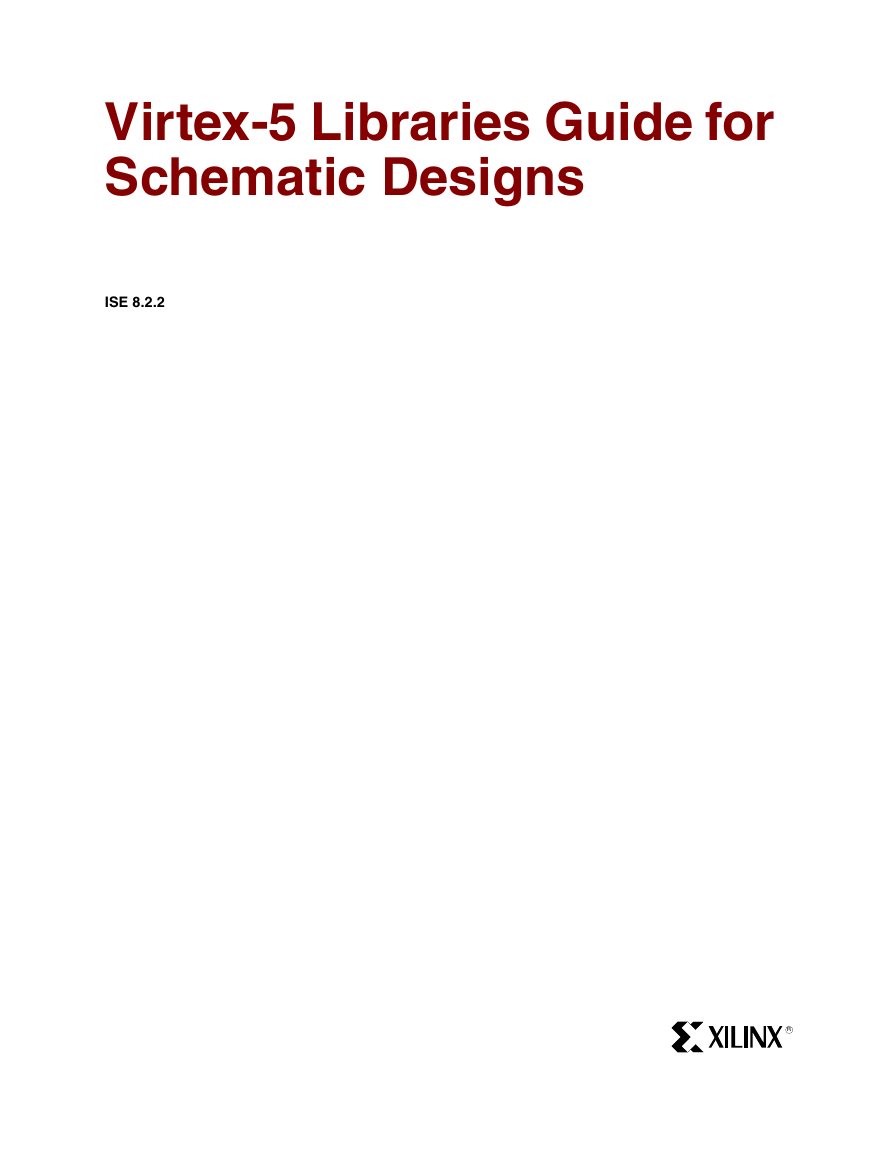
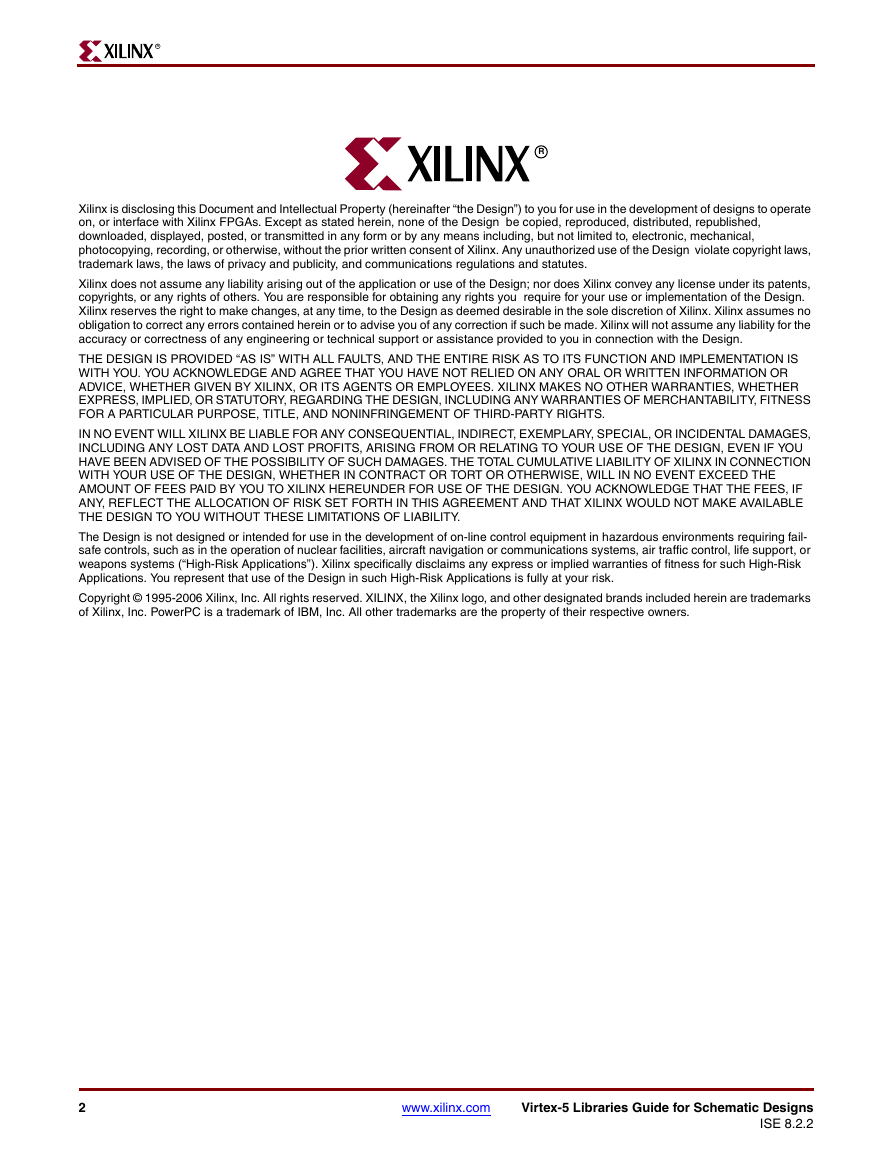
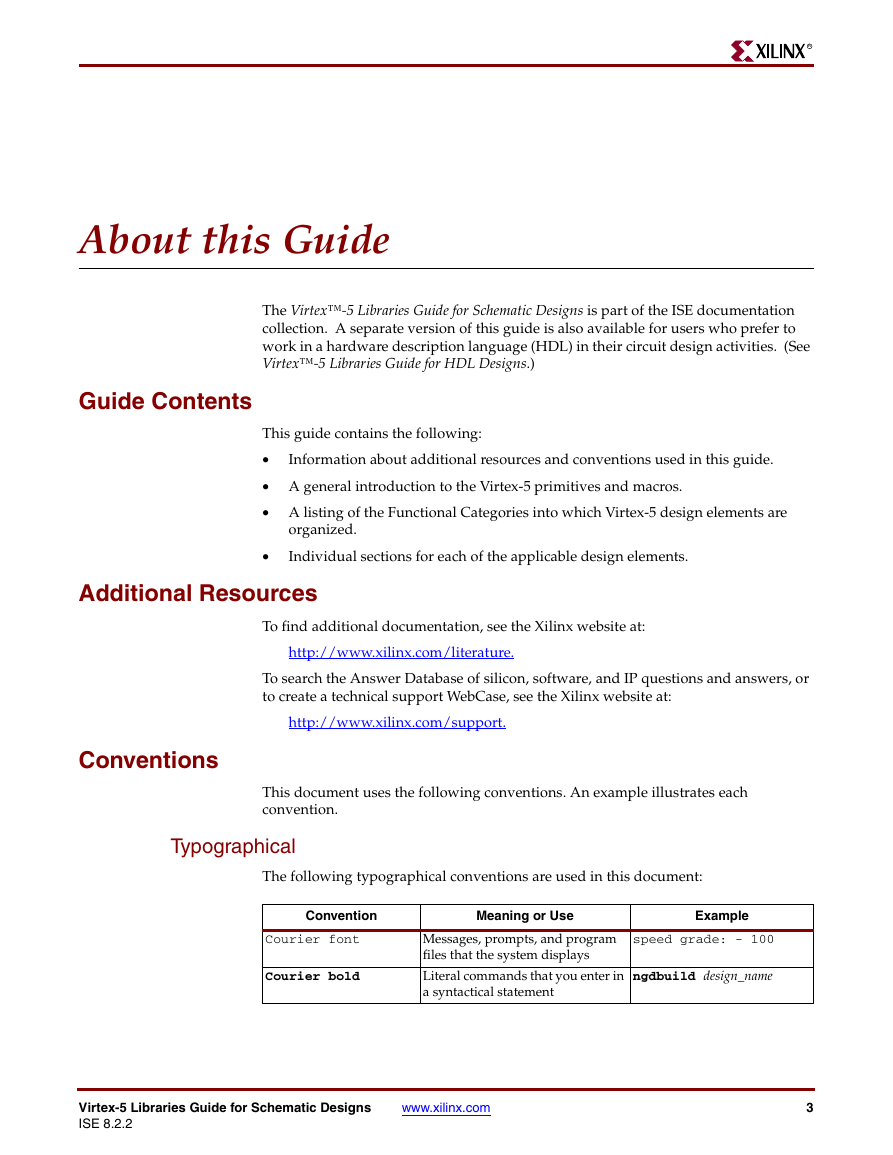
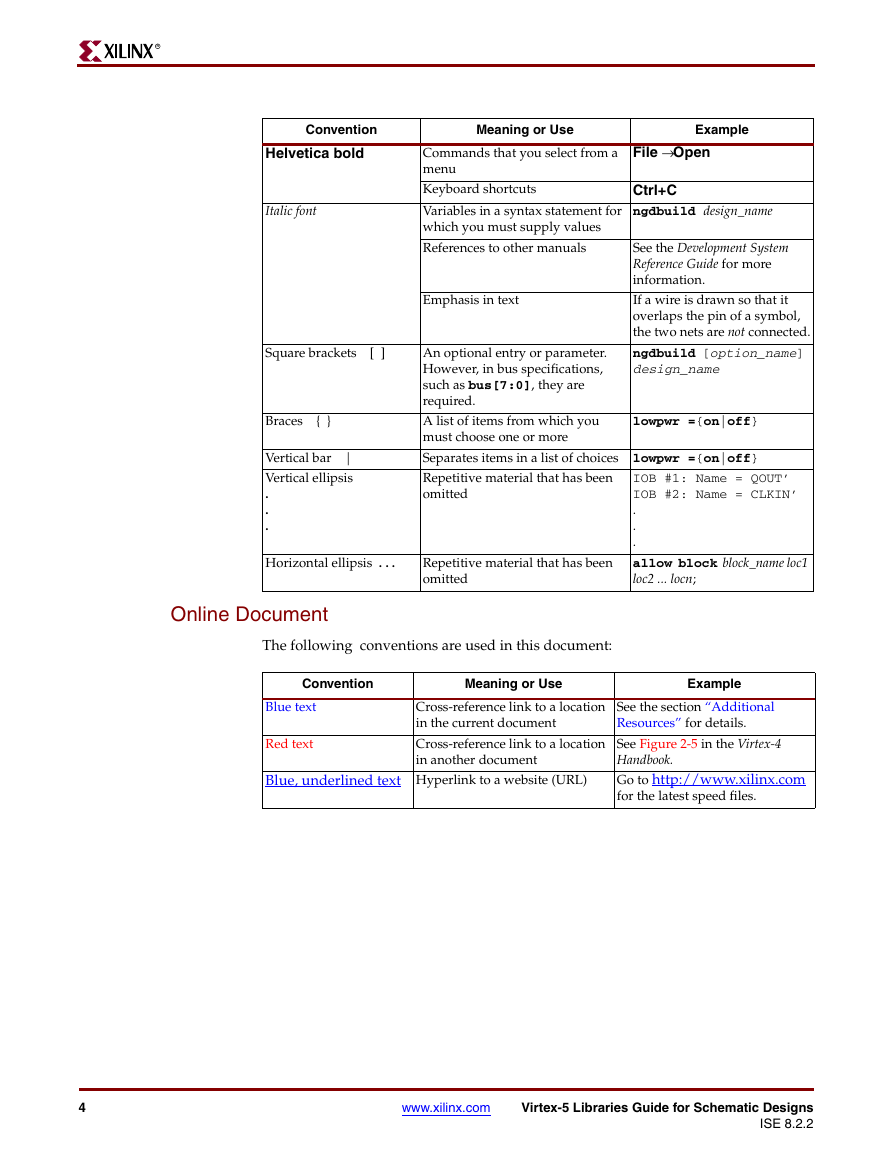
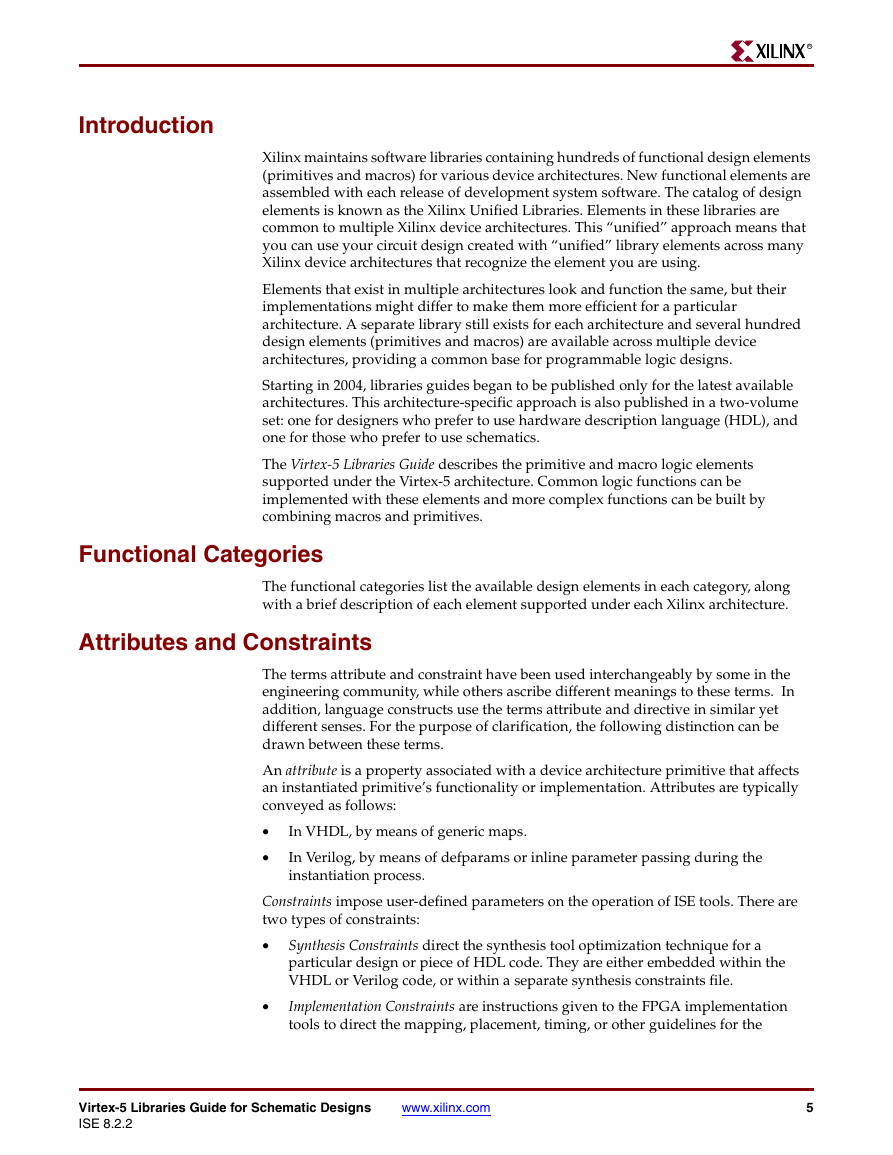
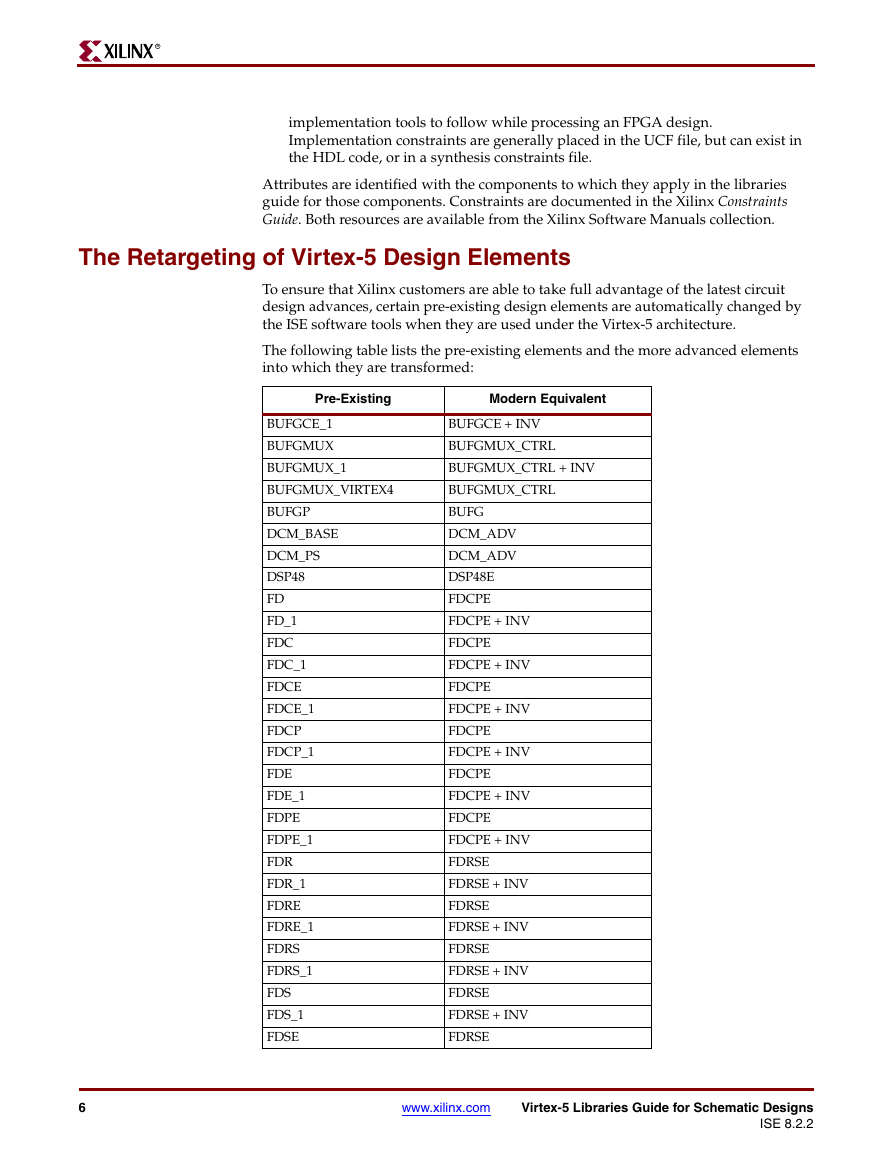
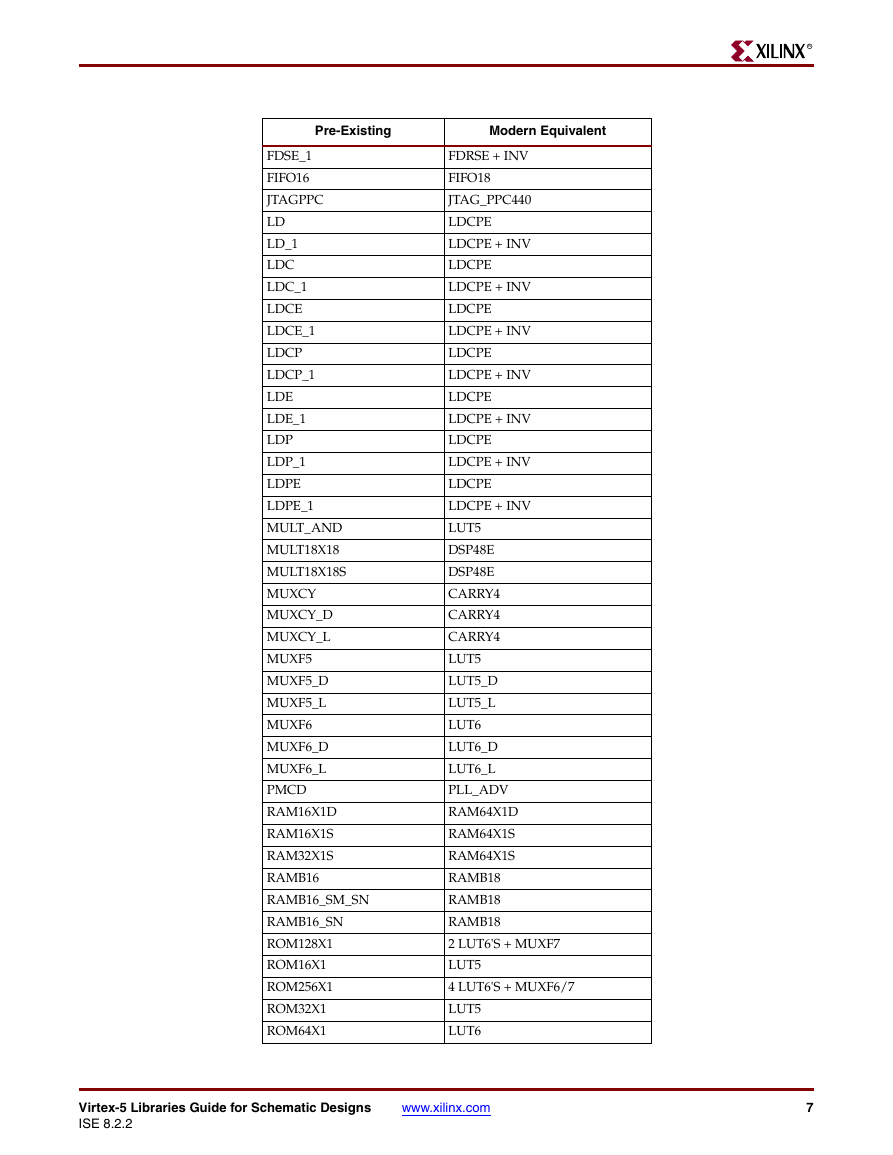









 2023年江西萍乡中考道德与法治真题及答案.doc
2023年江西萍乡中考道德与法治真题及答案.doc 2012年重庆南川中考生物真题及答案.doc
2012年重庆南川中考生物真题及答案.doc 2013年江西师范大学地理学综合及文艺理论基础考研真题.doc
2013年江西师范大学地理学综合及文艺理论基础考研真题.doc 2020年四川甘孜小升初语文真题及答案I卷.doc
2020年四川甘孜小升初语文真题及答案I卷.doc 2020年注册岩土工程师专业基础考试真题及答案.doc
2020年注册岩土工程师专业基础考试真题及答案.doc 2023-2024学年福建省厦门市九年级上学期数学月考试题及答案.doc
2023-2024学年福建省厦门市九年级上学期数学月考试题及答案.doc 2021-2022学年辽宁省沈阳市大东区九年级上学期语文期末试题及答案.doc
2021-2022学年辽宁省沈阳市大东区九年级上学期语文期末试题及答案.doc 2022-2023学年北京东城区初三第一学期物理期末试卷及答案.doc
2022-2023学年北京东城区初三第一学期物理期末试卷及答案.doc 2018上半年江西教师资格初中地理学科知识与教学能力真题及答案.doc
2018上半年江西教师资格初中地理学科知识与教学能力真题及答案.doc 2012年河北国家公务员申论考试真题及答案-省级.doc
2012年河北国家公务员申论考试真题及答案-省级.doc 2020-2021学年江苏省扬州市江都区邵樊片九年级上学期数学第一次质量检测试题及答案.doc
2020-2021学年江苏省扬州市江都区邵樊片九年级上学期数学第一次质量检测试题及答案.doc 2022下半年黑龙江教师资格证中学综合素质真题及答案.doc
2022下半年黑龙江教师资格证中学综合素质真题及答案.doc